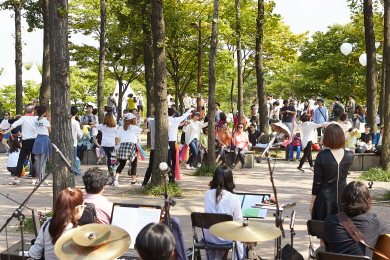
“Dancing energizes me,” said Kim Yoon-jin, who graduated from the Department of Dance in 1992. “I experience freedom through dancing.”
So begins the story of Kim, the director of the Seoul Dance Project and a professor of the Department of Dance at Kookmin University. Seoul Dance Project is a public art project run by the Seoul Foundation for Arts and Culture aiming to vitalize citizens’ lives through dancing. Kim has been working as the director of the project since 2013.
Kim has loved dancing since childhood. When she was seven, she badgered her parents until they let her attend dance classes. Although her parents did not consider dancing as a promising career, they could not deny what their daughter desired so greatly.

“Back in those days, most people considered dancing as a crude profession,” Kim said. “My uncle used to tell my mother that she was turning her own daughter into a cheap entertainer.”
Such remarks, however, could not discourage Kim’s passion toward dancing. It only made her more determined to prove that dancing is a wonderful art that should be shared and enjoyed more extensively. She carried this resolution into her university life, where she participated in an unofficial student club named “Genius & Inferiority.” The name of the club was inspired by the movie Amadeus. In the film appears a talented musician Salieri who nurses a secret feeling of inferiority, sustained in awe of his contemporary musical genius Wolfgang Amadeus Mozart.
“Salieri was not a genius himself, but he had the gift of recognizing one,” Kim explained. “The rest of the club members and I admired that insight, which is why we named the club ‘Genius and Inferiority.’ Not all of us can be geniuses, but we can at least learn to spot and admire those who are. At the same time, we can try harder to be geniuses in our own unique way.”
“Genius & Inferiority” consisted of students who majored in Dance, and wanted to create and experience art outside the school curriculum. Unlike official clubs and activities that were under faculty supervision, “Genius & Inferiority” ran seminars and performed dances on their own. With an affectionate laugh, Kim described the club as an “underground organization.”
“I liked to experiment outside the school boundaries,” Kim said. “Students were not allowed to put on a performance outside the school campus without a professor’s supervision. However, the club members once went ahead and borrowed an art gallery where we performed our own choreographed dance. Later the professors found out and we were told off, but we just carried right on in a more secretive manner.”
“Genius & Inferiority” was also active on campus as well. When Kim was a student, it was a norm for departments and clubs to set up bars during the Daedong Festival. However, “Genius & Inferiority” members of the Department of Dance begged to differ.
“We could have just set up a bar like everyone else, but where is the individuality in that?” Kim said. “As dancers, we wanted to do something dance-related during the festival. So the members and I requested the student government that we be allowed to perform.”
This is how “Genius & Inferiority” came to put on a performance in front of the Welch-Ryang Auditorium to celebrate the festival. The choreography was not the complicated nor confusing movements that were often seen on professional stages. The dance moves, created by the club members, were simple yet beautiful enough that the rest of the students and the visitors to the festival were also inspired to join in.

“I did not and still do not believe in exclusive dances,” Kim said. “People often see dancing as some form of highly specialized art that can only be enjoyed by a specific group of people, such as trained dancers. However, dancing is for everyone.”
Such perception of dancing stayed with Kim long after she graduated, and bloomed into something more. In 2013, the Seoul Foundation for Arts and Culture began the Seoul Dance Project. Initially, Kim was casted as the consultant of the project, but as she became more involved with the details, it was decided that she would take up the post of director instead.
The Seoul Dance Project is made up of five smaller projects: Guerilla Dance Party, Chumbaram Community, Community Dance Lap, Seoul Dance Party and Chair Dance. The project is carried out from spring to fall, wrapping up with the annual Seoul Dance Party as the grand finale.
Last year, the third Seoul Dance Party took place on Sept. 19 on Seonyoo Island. It was a merry, all-day-long festival enjoyed by all those who had participated in Seoul Dance Project that year, including ordinary citizens. During the festival, different dance communities staged off their amateur performances, and various dance-related events such as the Dance Golden Bell and the Makchum Dancing Contest were held.
“Everyone needs a little deviation from their daily lives,” Kim said. “Seoul Dance Project, especially the Seoul Dance Party, helps people keep the balance between deviation and routine by allowing them to express their emotions through dancing.”
Although she is very fond of her current life, Kim does not want her case to become the ultimate standard for anyone and emphasizes the importance of individuality.
“My life is great, but I don’t want to tell anyone to live exactly like me,” Kim added. “No one can become a role model for everyone, however admirable his or her lifestyle might be. People have their own unique traits, and they should actively cultivate those own traits instead of following others.”
In order to do so, Kim suggested to be free of perfectionism.
“You should not try too hard to be someone else’s definition of ‘perfect,’” Kim said. “Do your best with what you have, and you will be awed by just how much it brings into your life.”

